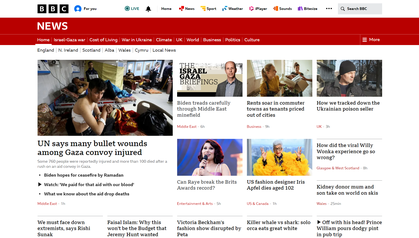How Information Online Is Changing the Means We Consume Info
In the digital age, the consumption of news has gone through a seismic change, offering both complicated challenges and extraordinary possibilities. The immediacy of on-line news platforms enables people to accessibility details immediately, customized to match individual interests through advanced algorithms. Nonetheless, this ease elevates critical questions concerning the reliability of sources and the possibility for prejudice, as curated web content can accidentally create resemble chambers. As we browse this progressing landscape, it ends up being important to discover how these adjustments affect our understanding of the world and the implications for educated decision-making in society.
Immediate Access to Information

With the arrival of electronic technology, the method we eat news has undergone a significant change, supplying instant access to details at our fingertips. The immediacy of digital information means that stories can be reported and distributed nearly immediately, eliminating the time lag that was integral in print and tv media.
Online news outlets have actually maximized this capacity by developing dedicated apps and websites that deliver damaging information informs straight to our tools. This continual circulation of details makes sure that the general public remains involved and aware of current affairs, promoting a more educated culture. In addition, the ease of access of digital news across several tools-- tablet computers, mobile phones, and computers-- has actually made it hassle-free for target markets to access information anytime and anywhere.
Nevertheless, this fast dissemination also introduces challenges, such as the possibility for false information to spread quickly. The stress to publish quickly can occasionally compromise precision, highlighting the requirement for extensive fact-checking and responsible journalism in the electronic age.
Individualized Content Delivery
Tailoring information usage to individual choices has come to be a defining attribute of the digital media landscape. With the advent of innovative algorithms and information analytics, information systems are increasingly able to supply material that aligns closely with customers' rate of interests and analysis practices. This customization not only enhances individual engagement however also makes certain that customers are subjected to one of the most prompt and appropriate information.
The procedure normally involves gathering information on the user's past communications, such as posts read, subjects of passion, and time invested on various content types. dw news. This information is after that analyzed to predict the customer's choices and to curate a customized information feed. Because of this, individuals receive a streamlined circulation of details that matches their unique rate of interests, consequently creating a much more effective and enjoyable news usage experience
In addition, customized material shipment has considerable ramifications for media firms. By developing more targeted content, these companies can increase visitor retention and interaction, bring about possibly greater advertising and marketing earnings. Nevertheless, this technique likewise increases worries regarding echo chambers, where individuals might only come across perspectives that strengthen their current ideas. As such, striking a balance in between customization and varied web content exposure continues to be an essential challenge for the sector.
Interactive and Engaging Styles
Embracing interesting and interactive formats has transformed the way target markets take in news online, offering a more immersive and participatory experience. Traditional information shipment, once a one-way interaction network, is currently being replaced by dynamic multimedia discussions, interactive graphics, and data visualization devices. These innovations not only catch the audience's focus but additionally improve comprehension by permitting individuals to explore info at their own speed. Interactive aspects such as clickable infographics, video clip explainers, and real-time data assimilation help with a much deeper understanding of complicated subjects, transforming easy viewers into energetic participants current narrative.
Moreover, live-streaming and virtual truth (VIRTUAL REALITY) experiences have become sophisticated devices in the world of electronic journalism. Live-streaming enables audiences to witness occasions as they unfold, cultivating a sense of immediacy and authenticity. At the same time, virtual reality offers an unmatched degree of engagement, moving customers right into a simulated atmosphere where they can experience tales first-hand. These layouts are specifically reliable in covering breaking information and unfolding occasions, offering a front-row seat to global occurrences.
The Role of Social Network
Social network's pervasive influence has redefined the landscape of news consumption, transforming it right into a more democratized and interactive experience. Systems such as Twitter, Facebook, and Instagram have actually come to be central centers for information dissemination, allowing users to access info instantaneously and share it commonly. This ease of access enables individuals to not just eat information but also involve with it, promoting a space where diverse voices can contribute to the discussion.

Social media site's algorithm-driven personalization tailors the information experience to specific preferences, potentially raising interaction. However, this can likewise create echo chambers, where individuals are exposed primarily to point of views that enhance their present beliefs. In spite of this, the duty of social media in news intake stays critical, bridging the void between info suppliers and audiences, and reshaping just how people interact with news in the electronic age.
Difficulties of Online News
While the electronic improvement of news this article delivery uses unprecedented accessibility and immediacy, it additionally provides considerable challenges that make complex the landscape look at here now of info usage. One primary concern is the spreading of false information and disinformation, which can spread swiftly throughout electronic platforms. This offers troubles for consumers in discerning trustworthy sources from those that are less trusted, possibly resulting in prevalent mistaken beliefs.
The speed at which information is supplied on the internet commonly prioritizes timeliness over precision. In the race to be initially, some outlets might release unverified information, which can later prove to be incorrect, deteriorating public rely on media. Additionally, the echo chamber result, facilitated by formulas that tailor material to customer preferences, can enhance existing predispositions and limitation exposure to diverse viewpoints.
Monetization methods even more make complex the landscape. The reliance on advertising earnings incentivizes sensationalism and clickbait, eclipsing substantive journalism. Paywalls, while necessary for monetary sustainability, can limit access to high quality information, exacerbating info inequality.
Final Thought
The change of news consumption with on the internet platforms has substantially modified info gain access to and engagement. A balanced approach is vital to harness the advantages of on-line information while mitigating its fundamental risks.

As an outcome, individuals receive a structured flow of details that matches their special rate of interests, consequently producing a more reliable and rewarding information usage experience.
Platforms such as Twitter, Facebook, and Instagram have become main hubs for information dissemination, allowing users pop over here to accessibility info quickly and share it widely. Despite this, the duty of social media in news intake stays crucial, connecting the void between information carriers and audiences, and improving how individuals communicate with news in the electronic age.